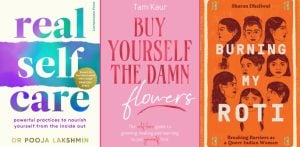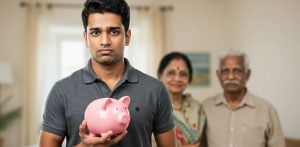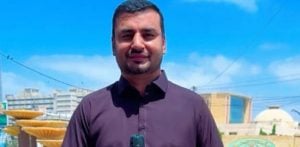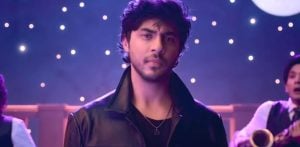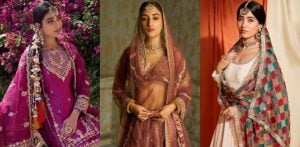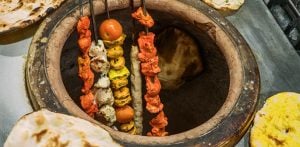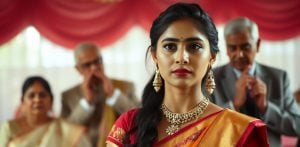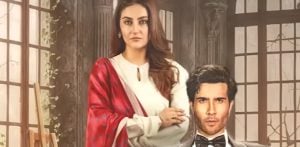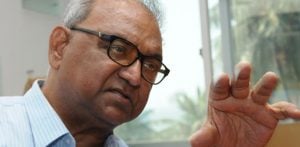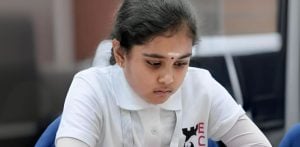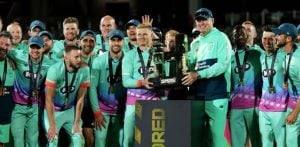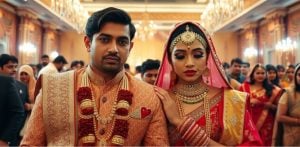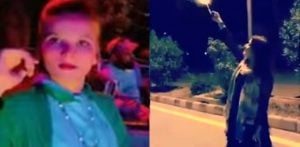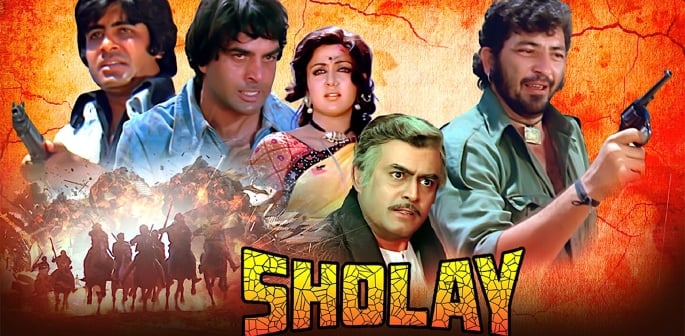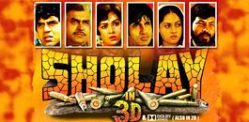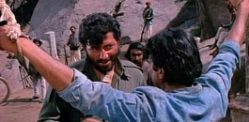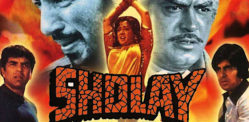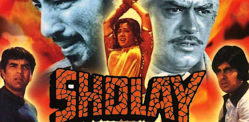Sholay is a historic landmark of Indian cinema.
Many Bollywood fans continue to love and admire Ramesh Sippy’s classic, Sholay.
The film was released on August 15, 1975, and over the decades, it has carved an indelible mark on the hearts of the audience.
However, what we see onscreen was created through painstaking effort, and interesting anecdotes lie within the film’s production.
The dialogues, characters, and scenes from the movie remain iconic.
As much as older Bollywood connoisseurs love the film, Sholay also finds newer fans in each generation.
In a glorious celebration of one of the greatest stories ever told, join us as we explore the origins of the film and what made Sholay the masterpiece it is.
Scripting
![]() Sholay tells the story of the policeman, Thakur Baldev Singh (Sanjeev Kumar), whose family is brutally murdered by the ruthless dacoit, Gabbar Singh (Amjad Khan).
Sholay tells the story of the policeman, Thakur Baldev Singh (Sanjeev Kumar), whose family is brutally murdered by the ruthless dacoit, Gabbar Singh (Amjad Khan).
Gabbar mercilessly goes on to sever Thakur’s arms from his body.
Thakur then enlists the help of the criminals, Veeru (Dharmendra) and Jai (Amitabh Bachchan), to help him get revenge on Gabbar.
The village of Ramgarh must also be freed from Gabbar’s terror.
Along the way, Veeru finds love in the happy-go-lucky Basanti (Hema Malini), while Jai develops feelings for Thakur’s widowed daughter-in-law, Radha (Jaya Bachchan).
The legendary screenwriting duo Salim-Javed, comprising Salim Khan and Javed Akhtar, achieved their big break with Ramesh Sippy’s Andaaz (1971).
In 1973, Salim-Javed created a four-line pitch of a story that would become Sholay.
Interestingly, several of the top filmmakers of that time rejected the idea until Salim-Javed contacted GP Sippy and his son Ramesh.
Taken in by the premise, Ramesh asked the writing duo to develop it further.
Sholay was inspired by Seven Samurai (1954) and was influenced significantly by dacoit culture.
The themes of the film were also borrowed from previous Bollywood movies, including Mera Gaon Mera Desh (1971), Mother India (1957), and Gunga Jumna (1961).
Some scenes in the screenplay were influenced by Hollywood material like Once Upon a Time in the West (1968) and The Magnificent Seven (1960).
The British film North West Frontier (1959) also inspired the famous attempted train robbery in Salim-Javed’s script.
Although Sholay has plenty of influences from previous material, it was unlike anything Bollywood had ever seen.
The originality in the film, such as the rocky terrain and the captivating characters, makes the film stand out like the embers in its title.
Casting & Characters
 Gabbar Singh
Gabbar Singh
When we watch Sholay now, we can’t imagine anyone other than the actors we see in their respective roles.
However, it may be surprising that the cast was not the original group of actors that were originally envisioned for the film.
The character of the ruthless Gabbar Singh was one of the hardest roles to cast.
Gabbar was based on the real-life dacoit Gabbar Singh Gujjar, who was a danger to villages near Gwalior in the 1950s.
The villain in Sholay was not stereotypically bad due to poverty or society. He was created to be purely evil.
Danny Denzongpa was originally approached to play Gabbar, but prior commitments prevented him from accepting the offer.
Sanjeev Kumar, who was in talks to join the cast, wanted to play Gabbar. In an attempt to convince the producers, he even stained his teeth black.
However, Salim-Javed thought that Sanjeev had won the hearts of the audience through his previous work.
As Gabbar had to be evil, there was no space for an actor who already had empathy and baggage from viewers.
Thereafter, Amjad Khan, who was then a newcomer, was signed. To prepare for his role, Amjad researched extensively on dacoits.
Thakur Baldev Singh & Veeru
For the role of Thakur, Pran was considered. But Ramesh felt that Sanjeev was a better choice.
Salim-Javed also approached Dilip Kumar to play the character. The veteran actor turned down the role, but he later admitted that he regretted this decision.
Dharmendra initially expressed interest in playing Thakur Baldev Singh.
However, he agreed to play Veeru after discovering that he would be romantically paired opposite Hema Malini, whom he was in love with.
Dharmendra also did not want to risk Sanjeev playing Veeru, especially since he knew about the latter’s history with Hema.
Jai
For over five decades, Amitabh Bachchan has been an everlasting icon of Indian cinema.
However, when Sholay was in the making, he was yet to gain a footing on the ladder of success.
Ramesh originally had Shatrughan Sinha in mind for Jai’s role. However, Amitabh desperately wanted to be a part of the project.
Salim-Javed had previously worked with Amitabh in Zanjeer (1973). They recommended him to Ramesh.
Furthermore, Amitabh requested Dharmendra to put in a good word for him, which ultimately resulted in Amitabh gaining the role.
The actor filmed Sholay and Yash Chopra’s Deewaar (1975) simultaneously. He used to shoot for Sholay during the day while reserving his evenings for Deewaar.
Zanjeer, Deewaar, and Sholay, all of which are Salim-Javed scripts, are believed to be the three films that firmly put Amitabh on the crest of phenomenal success.
Other Characters
The beauty of Sholay is that it is not only the principal characters that are remembered.
Each character, right from the villagers to the accomplices in Gabbar’s gang, is memorable.
Such characters include the Jailor (Asrani), who was based on Charlie Chaplin’s interpretation of Adolf Hitler in The Great Dictator (1940).
Viju Khote brings Gabbar’s slave, Kaalia, to life. His role is brief, but Kaalia’s influence is felt by fans.
Years after Sholay, Viju made a special appearance as himself in Atithi Tum Kab Jaoge (2010).
In that film, Paresh Rawal (Lambodar ‘Chachaji’ Bajpal) irritates him to no end out of his love for his Sholay character.
Without question, one of the biggest strengths of Sholay is its characters, played by actors who fitted their roles appropriately and iconically.
Popular Dialogues
![]() In the 1970s, Salim-Javed gave a new identity to the art of screenwriting in Bollywood.
In the 1970s, Salim-Javed gave a new identity to the art of screenwriting in Bollywood.
When asked about the pay disparity in the industry, Aamir Khan says:
“There was a time when Salim-Javed were the highest-paid people. They used to get paid more than the actors.
“They pulled the crowds in.”
Aamir’s words recognising Salim-Javed’s talent are never truer in Sholay, where popular dialogue adorns the scenes.
For example, the aforementioned Kaalia gets his moment of glory when Gabbar asks him:
“Kitne aadmi the?” (How many men were there?). This is about his failure to kill Jai and Veeru.
Elsewhere, a sparkling scene where Jai attempts to talk a drunk Veeru down from a water tank is a highlight of the film.
Veeru is later captured by Gabbar. When Basanti rushes to him, Gabbar orders her to dance for him and his men.
In response, Veeru shouts: “Basanti, inn kutton ke saamne mat nach na!” (Basanti, don’t dance in front of these dogs!).
This scene and the dialogue inspired the song, ‘Basanti No Dance‘, in Hrithik Roshan’s Super 30 (2019).
In early parts of the film, when Basanti and Veeru first meet, Veeru excitedly chats to her as she rides her famous horse, Dhanno.
Meanwhile, an irritated but amused Jai lazes in the back of the tonga (horse-carriage).
Basanti, in her gregarious, loud personality, constantly proclaims her name. However, at one point, she asks Veeru: “You haven’t asked me my name.”
Jai interrupts and asks absent-mindedly:
“Tumhara naam kya hai, Basanti?” (What’s your name, Basanti?).
This also balances the humour and emotion of the film.
When asked about the longevity of the dialogues from Sholay, Javed Akhtar replies:
“The fact is, even today, a minor character from Sholay, who has uttered three words, or who just stood there, is used in stand-up comedies.
“He is referred to in other films’ dialogues. He has even become the reference in political speeches.
“People use their lines such as ‘Tera kya hoga, Kaalia’, ‘Arre o Samba’ and ‘Poore pachaas hazaar’.
“When you mention ‘Mausi said this’, everybody will know which Mausi you are talking about.”
Music
![]() The music of Sholay is composed by the legendary maestro, RD Burman.
The music of Sholay is composed by the legendary maestro, RD Burman.
Loved singers, including Manna Dey, Lata Mangeshkar, and Kishore Kumar decorate the soundtrack with their voices.
Kishore Da and Manna Sahab have a lovely duet together, ‘Yeh Dosti‘.
The song is an anthem of Jai and Veeru’s unconditional friendship.
This number remains a top choice for Bollywood fans who wish to celebrate their friends and close ones.
However, the most famous song from the film is arguably ‘Mehbooba Mehbooba‘, sung by RD Burman himself.
To create the beats of this number, Burman blew through beer bottles.
The song is adapted from ‘Say You Love Me‘ by Demis Roussos and showcases a gorgeous Helen dancing for Gabbar.
An enthusiastic Jalal Agha accompanies the performance, lip-syncing perfectly to Burman’s gravelly voice.
Dharmendra and Hema also get their musical moments with romantic numbers by Kishore Da and Lata Ji.
Lata Ji’s ‘Haa Jab Tak Hai Jaan‘ achieved fame by presenting Basanti dancing barefoot on broken glass for Gabbar and his gang.
The song also inspired the title of Yash Chopra’s 2012 swan song.
Lata Ji’s high vocals, filled with emotion and restraint, emphasise Basanti’s undying love for Veeru and the pain she is willing to endure to save him.
The music of Sholay undeniably contributes to its global legacy.
From a Flop to a Classic
![]() It may come as a shock that Sholay was a failure at the box office when it was originally released.
It may come as a shock that Sholay was a failure at the box office when it was originally released.
The film’s unusual premise and unglamorous locations led critics to slate the movie.
Dilip Kumar said the film could have been more romantic, while Naseeruddin Shah has claimed that “it is not a good film from any angle”.
The makers considered changing the film so that Amitabh’s character of Jai lived instead of dying.
However, popular word-of-mouth eventually led to the film’s fortunes changing.
Sholay went on to break records and become the highest-grossing Bollywood film at that time, overtaking Mughal-E-Azam (1960), which had previously held this title.
The film also ran for five years in Mumbai’s Maratha Mandir Theatre.
Sholay was in production for five years, and the lengthy process ultimately paid off.
For the film, two endings were shot. One of the climaxes – which was attached to the final cut – shows Thakur sparing Gabbar’s life to preserve law and order.
In another, Thakur does kill the dacoit, then breaks down in Veeru’s arms.
Censors pushed producers to incorporate a more lawful ending to honour the judicial system.
Impact & Restorations
![]()
5 Unique Facts about Sholay:
- Dharmendra would pay for retakes to allow him more time with Hema Malini.
- Jaya Bachchan was pregnant with Abhishek Bachchan during filming.
- To prepare for his role, Amjad Khan read a book on dacoits by Jaya Bachchan's father.
- Ramesh Sippy wanted to repeat his 'Sholay' cast in 'Shaan', but this never materialised.
- 'Sholay' was referenced in the BBC's EastEnders during a conversation between Dotty Cotton and Vinny Panesar.
The impact Sholay continues to have on Indian cinema is unprecedented.
Other than its aforementioned influences on subsequent material, the film is regularly mentioned on lists of the most iconic Indian classics.
Karan Johar described the film as “a textbook of Indian cinema”.
The film certainly has all the elements of Bollywood to glistening standards, including music, romance, action, and emotion.
Gabbar Singh particularly remains an iconic villain, with many celluloid baddies taking influence from the character.
These include Mogambo (Amrish Puri) in Mr India (1987) and Shakaal (Kulbhushan Kharbanda) in Shaan (1980).
Anupama Chopra called the film “the gold standard in Indian cinema”, and she published a book titled Sholay: The Making of a Classic (2000).
In 2014, Sholay was re-released in 3D and has been digitally restored using colour reversal intermediates. New scenes have also been added.
Shivendra Singh Dungarpur, director of the Film Heritage Foundation, reflected:
“Despite the fact that we could not use the original camera negative and that not a single 70mm print survives, we have left no stone unturned to ensure that this historic film has not only been beautifully restored, but that the restored version that will premiere in Bologna will have the original ending and some never-before-seen deleted scenes.”
In August 2025, it was announced that the Film Heritage Foundation would re-release Sholay that September to celebrate the film’s 50th anniversary.
Speaking about this occasion, leading man Amitabh Bachchan said:
“Some things in life remain permanently etched in your mind. Sholay is one such film.
“Shooting for the film was an unforgettable experience, but at the time I had no idea that it would be a watershed for Indian cinema.
“Its dramatic change in fortunes from being declared an unsuccessful venture, to its record-breaking box office run was an emotional rollercoaster for all of us.
“It’s wonderful that the Film Heritage Foundation has restored Sholay and that they have managed to locate and include the original ending as well as some deleted scenes in the restoration.
“I hope that even 50 years later, the film will capture the imagination of new audiences across the world.”
Sholay is a historic landmark of Indian cinema.
It has a rich legacy of unforgettable music, characters, and dialogues.
In this shining mosaic lies a diligent journey of creativity, effort, and originality.
This is one of those films that embodies the phrase: “Never gets old”.
So, go ahead and continue celebrating the enduring sensation, Sholay.
Step into Ramgarh and watch the full movie here!






